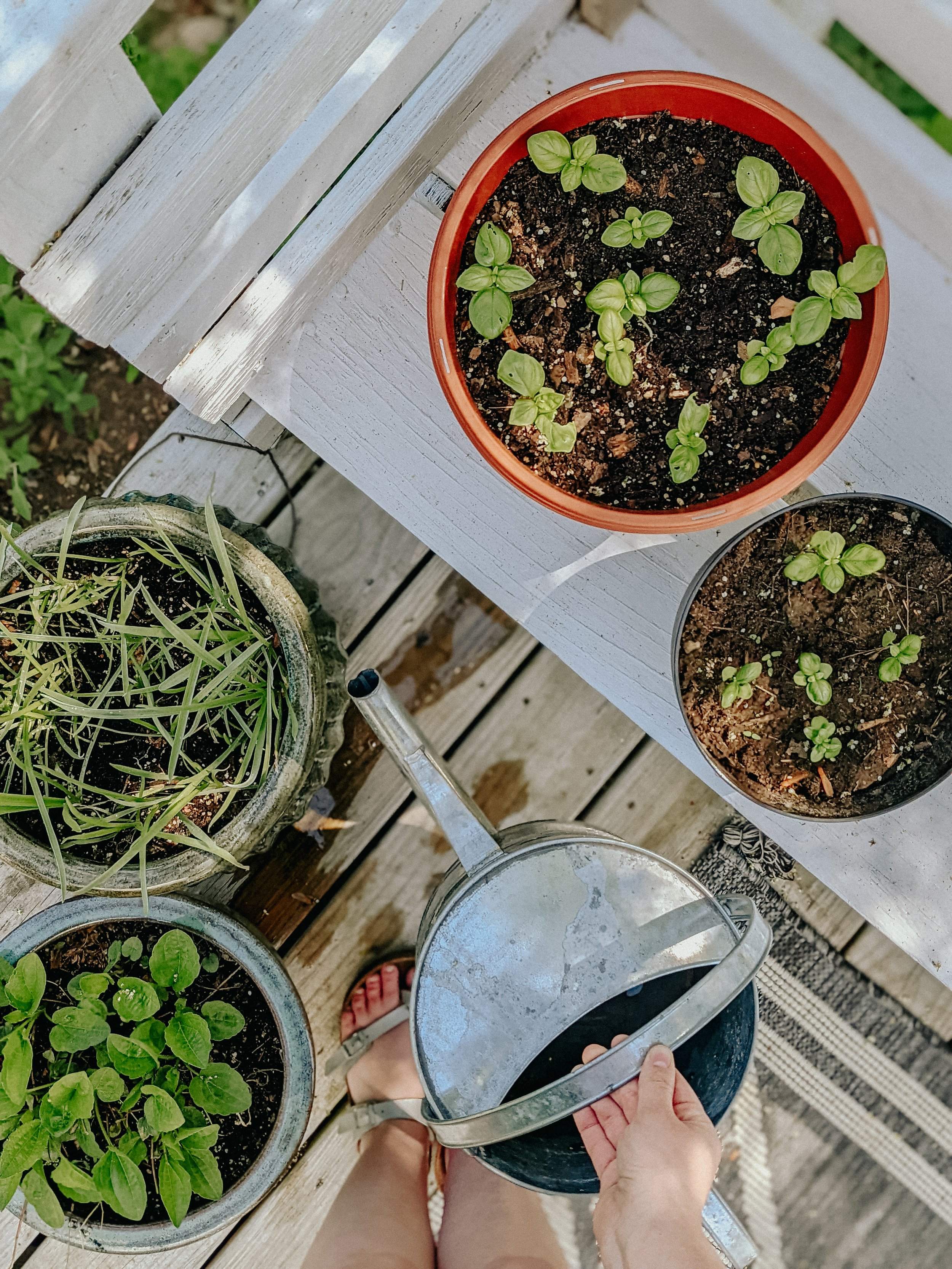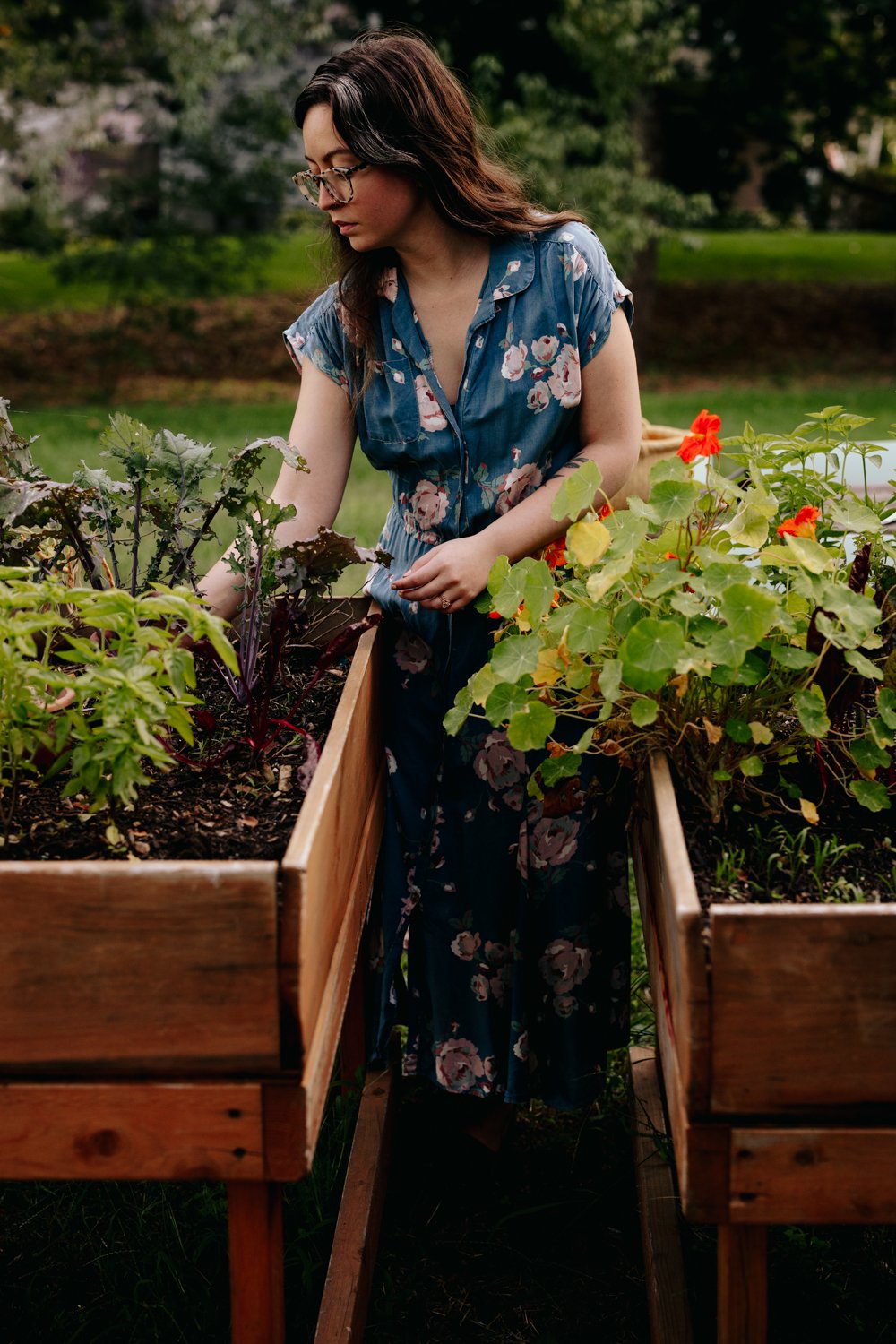BACKYARD GARDENING MADE SIMPLE
No More Over or Under Watered Plants: A Comprehensive Guide to Watering Your Garden
We’ve talked a lot about creating systems in your garden to grow more food even with chronic pain and fatigue, and you can find lots more of my tips on that by clicking here. But I wanted to dive deep into how to water plants with chronic illness today because - at least for me - watering plants has been a huge struggle.
Unwieldy hoses and heavy watering cans plus the time required just standing there combined with the fact that skipping a day of watering in the hot and dry season because you aren’t feeling well isn’t really an option leads to this being a constant source of stress. The good news is that there are many different ways to water your plants no matter your budget or energy levels.
The Cottage Peach is reader-supported. When you purchase through links on our site, we may earn an affiliate commission at no additional cost to you. All opinions are our own.
We’ve talked a lot about creating systems in your garden to grow more food even with chronic pain and fatigue, and you can find lots more of my tips on that by clicking here. But I wanted to dive deep into how to water plants with chronic illness today because - at least for me - watering plants has been a huge struggle. Unwieldy hoses and heavy watering cans plus the time required just standing there combined with the fact that skipping a day of watering in the hot and dry season because you aren’t feeling well isn’t really an option leads to this being a constant source of stress. The good news is that there are many different ways to water your plants no matter your budget or energy levels.
How to Water Plants
Knowing how and when to water your plants in your garden sounds scarier than it is, I promise! While some plants may have more specific watering requirements, as a general rule you want to keep the soil consistently damp throughout the germination process, and then once your plants are established you’ll wait for the soil to begin to dry out during the growing season.
Utilize mulching to prevent water loss due to surface evaporation
Concentrate your watering at the base of the plant
Confirm the soil isn’t already damp first
Water in the morning, so excess moisture can evaporate in the sun
When to water plants
Water infrequently but deeply in the morning to encourage resilient plants - 1” of water once per week. A 10-foot soaker hose (the kind with a spray nozzle) will release 6 gallons of water per foot in an hour’s time. For 1” of water coverage, you’ll need to run the hose for about 45 minutes.
How to water in-ground gardens
The best hack for watering in-ground gardens is mulch. Mulch will hold that moisture in so it doesn’t evaporate from the soil in hot dry weather. Once your plants are established (usually a couple of weeks after transplanting or about a month after direct sowing) in ground gardens are pretty self-sustaining in terms of water. During heat waves I will water once a day, but other than that as long as we’re getting some rain once a week or so I won’t water established in ground gardens much at all. Of course your plants will tell you if they are thirsty too by drooping, and if you don’t mulch at all things will be very different - this is when you’ll need to watch out for hydrophobic soil (see more info on that below)
How to water raised bed gardens
Standard raised bed gardens that are in contact with the soil underneath will need slightly more attention in watering than an in-ground bed since the growing soil is elevated slightly. Drip irrigation or olla watering systems work really well in raised beds, or you can follow the tips listed above. (click here to learn more about ollas)
How to water container gardens
Container gardens are notorious for drying out very quickly. You will need to water container gardens at least once per day - in a heat wave, sometimes twice per day. Raised beds that are elevated off of the ground like mine fall into the container garden category as well and benefit hugely from automatic watering systems like the irrigation trays included with my raised beds or an olla watering system.
Is it true that you shouldn’t get leaves wet when watering your plants?
I’m sure you’re wondering how you’re supposed to completely avoid getting the leaves of your plants wet while watering. The fact is, some plants (especially squash) are more susceptible to diseases that thrive in damp environments like powdery mildew. This doesn’t stop the rain from falling on your plants however, so I wouldn’t worry too much about avoiding any water getting on the leaves unless you are having an especially damp season (in which case, don’t water anyway!)
What is hydrophobic soil?
Hydrophobic soil occurs when a waxy residue builds up on the soil particles resulting in it repelling water rather than absorbing it. This can happen if you do not water consistently, or you don’t use mulching to protect the surface layer of your soil from drying out. You can tell that soil has become hydrophobic because the water will bead up and not soak into the earth normally. You can also confirm your soil is hydrophobic by digging down an inch or two beneath the soil after watering. The surface may look damp, but underneath the soil will be completely dry.
How to fix hydrophobic soil
The easiest way to correct hydrophobic soil is to amend it with nutrient rich compost. However, you most likely won’t be fixing the soil that is hydrophobic - you’re really just slowly replacing the soil that has gone “bad” by mixing in fresh new soil that can encourage better absorption.
My favorite low energy watering techniques
Water your garden with Ollas
Olla (pronounced oya) means “pot” in Spanish, but the concept of using ollas as an irrigation system goes back thousands of years and has been used in countless cultures around the world. An olla self watering system for plants is basically any type of unglazed clay pot that is buried beneath the soil with only a small amount sticking up above the surface and filled with water. You can tell that a pot is unglazed because it will be that classic terracotta red color with no shiny finish, glaze or paint. The water then leeches out of tiny holes or “pores” in the unglazed clay and is pulled through the soil to the roots of your thirsty plants using a process called soil moisture tension. This functions much the same way as osmosis, in that the water is trying to equalize to a certain level of moisture within the soil. This means your soil will never become overwatered either - if the soil is moist, the water stays in the pot until it is needed.
Olla pots reduce wasted water by about seventy percent, since most of the moisture is held underground and not lost to surface evaporation. This is a huge savings over traditional watering methods and means you can significantly reduce your water consumption in our drought-prone climate. This will lower your water bill as well as make your garden more environmentally friendly! They are also perfect for watering plants on vacation.
Olla pots also help you to grow happier and healthier plants. The root systems in your plants will also be healthier, as they reach out towards the underground water the roots will become larger and sturdier, keeping your plants from falling over. Most importantly, plants that are watered at the soil level are less prone to infection with certain fungal diseases that thrive in damp environments, since the leaves of your plants will not get wet as often. Because of the soil moisture tension phenomenon, your plants will also never be overwatered.
You can click here for my favorite ready-made ollas you can buy or click here for instructions on how to DIY your own.
Water your garden with drip irrigation
Drip irrigation combined with a timer will give you the most hands-off automatic watering for plants. You can truly just set it and forget it, leaving you free to focus your energy on garden tasks you enjoy. These systems run the gamut from complex DIY builds to custom built configurations, but for a ready made option I recommend this Garden Row Snip-n-Drip Soaker System. With this system you can easily create a customized watering system for rows of plants. The kit includes everything you need to water up to four 25' rows, and only takes about an hour to set it up at the beginning of the season. This way you can apply water just where you want it — and not where you don't. You can customize this convenient soaker hose system to suit your vegetable garden or any garden planted in rows. No special tools are required — just use scissors to cut the hoses to the sizes you need. Snap the fittings in place and you're ready to water. The weeping action of soaker hoses delivers water right to the roots, with minimal loss due to evaporation and runoff. Soaker hoses use up to 80% less water than sprinklers!
Water your garden with rainwater
Rainwater collection is an excellent option especially in drought prone areas. This is the rain barrel we use in our garden - the authentic oak barrel texture is molded into each plastic rain barrel and will not fade, rot or risk insect infestation. The unique flat back design allows the rain barrel to sit flush against any wall and is equipped with a durable brass spigot with hose hook-up as well as a screen to keep out debris and insects. Manufactured from rotomolded polyethylene, this rain barrel is impact resistant and UV stabilized to eliminate fading. Don’t forget a stand to elevate your rain barrel so you can have good water pressure to your hose and fill up your watering can easily.
Water your garden with sprinklers
Sprinklers are a great hands-off watering method. Try this Hi-Rise Lifetime Brass Sprinkler. In an age of plastic, one-season sprinklers, you'll appreciate these no-nonsense sprinklers built to last a lifetime, made of coated steel and solid brass. The jet nozzle creates a 360° spray of fine droplets without the need for failure-prone moving parts. Spiked base has a foot tread to make placement easy, and a second fitting so you can connect two sprinklers end-to-end with a feeder hose.
I hope these tips on how to water your garden were helpful. Gardening with chronic pain or fatigue doesn’t have to be harder with a little planning. How do you water your garden? Let me know in the comments!




